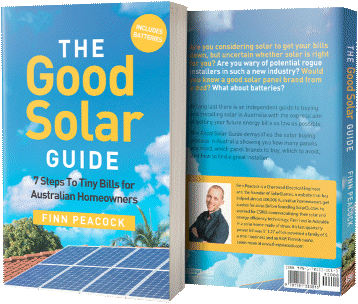
An article claiming a “sun tax” looms for solar power system owners in Queensland had the interwebs abuzz yesterday; well, a corner of it.
The paywalled article in a News Corp publication claimed solar owners are being urged to install battery systems ahead of this so-called sun tax that will see them charged for exporting surplus electricity when there is low demand for it. It certainly created a stir, with hundreds of comments by late yesterday afternoon. If you just read the headline and the first couple of paragraphs, a reader could be left with the impression this was just around the corner.
It isn’t, but let’s rewind things a bit first.
Australia’s electricity grid was originally designed for one-way electricity flows – into premises, not out from them. As more households and businesses across the country install solar power systems, electricity flowing back into the grid is increasing at a fairly rapid clip. System owners are (generally) paid for this electricity through feed-in tariffs.
But in parts of some electricity networks there can be very high levels of solar energy goodness flowing back into the grid at certain times of the day, making maintaining grid stability more challenging.
“Two-Way” Pricing Signals
One of the approaches to address the situation first proposed some years ago is the provision of two-way pricing signals to solar power system owners. These signals would encourage boosting self-consumption (which is the financially smart thing to do anyway) during times when there is risk of too much locally-generated solar electricity in the grid and not enough demand, but also to provide better rewards for exporting energy to the grid when it is needed.
Some focused solely on the take rather than the give, and screams of “SUN TAX!” soon reverberated around the nation.
Distributed Network Service Providers (DNSPs) in the National Electricity Market (NEM) had previously been banned from implementing surcharges on exports. Changes made by the Australian Energy Market Commission (AEMC) to National Electricity Rules and National Energy Retail Rules last year made them possible.
The Australian Energy Regulator (AER) was then given the job of developing draft Export Tariff Guidelines for two-way pricing that would cover a bunch of issues, including protections for solar owners. Feedback on the draft guidelines closed in March this year, and the final Export Tariff Guidelines were published in May.
Among the important points in the explanatory statement:
- Just because two-way pricing will be permitted, it doesn’t mean system owners will be charged to export solar electricity at all times, or at all.
- A basic export level where no charges can be applied must exist.
- Two way pricing, where it is implemented, must be carrot and stick, not just stick.
- The AER will not approve two-way pricing options unless a distributor can justify them in its particular circumstances. For example, if not taking action would result in the need for expensive network upgrades to support extra solar exports, the cost of which would otherwise be recovered via higher electricity bills for all.
- Two-way pricing proposals will need to be developed through genuine engagement with consumers.
- The earliest date two-way pricing cay be introduced in Queensland is July 1, 2025. This was briefly mentioned in the News Corp article, around two-thirds of the way down.
At this point, neither Energex or Ergon have submitted proposals for export tariffs, and the Queensland Government has previously signalled it is opposed to them.
Feed-In Tariffs Heading Up, Not Down
As well as the spectre of this so-called “sun tax” invoked in the article yesterday, LNP energy spokesman Pat Weir was quoted as saying solar owners are concerned feed-in tariffs are dropping.
But they aren’t dropping at the moment and a couple of weeks ago it was announced feed in tariffs in regional Queensland would be boosted 41% from July.
In South-East Queensland, electricity retailers aren’t compelled to pay anything for electricity solar households export to the grid, but in most cases they do. Comparing the rates in January to what they are currently, they’ve generally remained stable and chances are good they will increase given rising wholesale electricity prices.
When sanity finally prevails in the electricity market and wholesale prices start to drop again, feed-in tariffs will follow suit. That’s just how things work and this is not new.
For some years now the real value in installing solar panels – and there is plenty of it – has been in maximising self-consumption. Feed-in tariffs were originally set high regardless of wholesale pricing to encourage solar power system uptake when systems were significantly more expensive than they are now; and that mission was accomplished.
Commenting on the News Corp report, Minister for Energy, Renewables and Hydrogen Minister Mick de Brenni said:
“The Opposition Leader should apologise for scaremongering at a time when Queenslanders should be encouraged to install rooftop solar.”
The nature of the “sun tax” scare piece may have boosted enquiries about solar batteries – which is good for those selling them – but it also created a lot of unnecessary confusion and angst at a time when there is more than enough of both to go around.

 RSS - Posts
RSS - Posts



Bottom line.. I put in an $8k solar system to do my bit for the environment. I use most of the power generated myself (as intended) but QLD “solar tax” has Exceeded my cost of production, so I have little choice but to purchase / install batteries and disconnect from the grid altogether. Thanks to the gov. For the installation subsidy (about $3k) but now no thanks for charging Extra for being connected to the grid!
I’m one of the resident skeptics here on SQ, but what do you mean that the ”
QLD ‘solar tax’ has Exceeded my cost of production”?
There is no QLD solar tax nor is there a sun tax. Are you referring to daily supply charges + solar metre charges, plus the usage charges for when you have to import due to no or low solar generation?
Will you be getting a diesel\petrol generator as backup for periods when the sun is MIA and solar yield is 4 kWh or so for multiple days in a row? (I have a larger system. If you’re putting in a 5 kW inverter you can probably halve that yield to 2 kWh or so for multiple days in a row).
Who can afford petrol/diesel these days? 🙂
George Kaplan,
“Will you be getting a diesel\petrol generator as backup for periods when the sun is MIA and solar yield is 4 kWh or so for multiple days in a row?”
What would that cost, George? Let’s see, for example:
A Briggs & Stratton 6500w Inverter Generator capital cost is around $3.5k,
with 5 kw continuous (6.5 kW peak) capacity inverter output,
306 cc petrol motor with 19 litre capacity fuel tank (minimum 91 RON/ up to E10 grade),
up to 14 hours runtime per tank (with auto variable engine RPM adjusting to power demand),
1x 230 VAC / 50 Hz / 32 amp socket, 2x 230 VAC / 50 Hz / 15 amp sockets, 2x USB charging ports
3-year domestic use warranty
https://www.mygenerator.com.au/briggs-and-stratton-6500w-inverter-generator.html
With 19 litres of (minimum 91 RON grade) petrol consumed in up to 14 hours runtime before refilling, that represents a consumption rate of at least 1.36 litres per hour. With power demand near peak capacity fuel consumption would be more.
Average price per litre for E10 petrol today (Jun 24):
* Sydney: $2.13
* Melbourne: $2.02
* Brisbane: $2.16
* Adelaide: $2.05
* Canberra: $2.21
* Hobart: $2.08
https://fuelprice.io/nsw/sydney/?fuel_type=e10
MINIMUM run cost for E10 fuel to operate the genset referred above today is $2.74 per hour (Melbourne), $3.00 per hour (Canberra).
By the end of this year fuel prices may get near $3.00 per litre, or MINIMUM $4.00 per hour fuel consumption running costs. And I’d suggest it will likely get even more expensive in the next few years.
For business and residential stationary electricity generation applications, I suspect it’s now cheaper to have more solar-PV (and probably even battery storage) installed, even if export limited, compared with utilizing gensets, in the longer-term. Perhaps SQ might like to crunch some numbers?
I’ve had two comments I haven’t approved from people who are upset with a political party that’s been in power for three weeks over an AER report published in May. Bringing up relevant political issues is fine, but they have to make a minimum of bloody sense.
Queensland Labor has been in power since 2015 but my criticism pertained to the 1998-2012 period as this is mostly a state issue rather than a federal one.
For some odd reason QLD votes Coalition at the federal level, but Labor at the state level.
Okay, but the AER report is at the level of the National Electricity Market. It makes no specific mention of Queensland.
I appreciate that may not have been made clear in the post, but it’s important to check these things.
The AER report may be at the level of the NEM, but the 3rd part of this article is focused on Queensland, referencing the LNP, regional Queensland, SEQ, and quotes the QLD Minister for Energy, Renewables and Hydrogen who apparently has held the post since 2020, been in parliament since 2015, and yet remains (practically?) a complete unknown.
I am not sure how you are getting that FITs in SEQ will increase. I just looked at the AGL Website about their plans and the new Solar Savers Plan is changing dramatically, and not for the better. The terms are a lot more complicated, your system must be limited to an input of 30KWhr per day. The headline rate is now 10c per KWhr for the first 14 and then 5c for the rest. I am currently on 12c per KWhr only limited to that my is inverter has a max capacity of 10KW, I am also have an 8c per KWhr extra demand tariff between four and nine pm. My friend ,who got her plan 12months before me, is on 15c per KWhr and no demand tariff.
So solar customers in SEQ are not going to benefit from the electricity price hikes that this blog has been inferring for the last few months.
I would be happy to buy an electric car and use it to power my house in low/no solar situations, but this option doesn’t exist at present.
I think that it is joke that electricity suppliers want to charge the people that have installed solar panels to feed back to the grid when they already charge to have a feed in meter and only get paid 6 cents per kWh when the companies charge out at over 20 cents per kwh.
We should not be robbed blind by the greedy